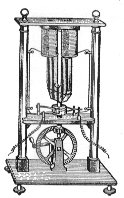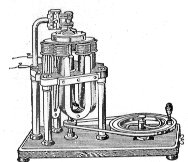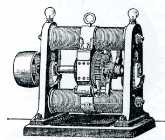Generatore
Descrizione
Descrizione
Generatore

Hippolyte Pixii generator - 1833 -
In some machines magnetic field rotate and the loop stay still.
The Pixii's generator was drived by hand. Ampere had suggested to Pixii to add a split-ring commutator to produce direct current. The alternating current gave problems heating the iron magnetic core by eddy currents.
In figure is showed the model built in 1833.
One of those generators is exposed at Science Museum of London.
In 1846 all was ready to build greater and more efficient generators to join to a steam engine.

Stoehrer generator - 1834 -

E.M.Clarke generator-1834
In those years was general opinion that the electomagnetic generators could have therapeutics properties.
It is not surprising if those generators were built in a large scale by Clarke and by others manifacturers.
The patient had to hold two metallic knobs and the amount of electricity depended on crank velocity.
Zenobe Thèophile Gramme built the first dynamos with practice dimensions capable to produce a true direct electric current.
The success of the Gramme machine was prompt and has been used for several applications as lighthouses, electrolating and electric light in the establishments. The dynamos of Gramme were drived by steam engines.

Dynamos of Gramme - 1870 -